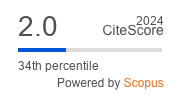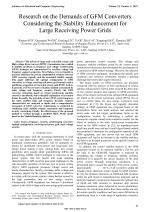| 1/2025 - 5 |
Research on the Demands of GFM Converters Considering the Stability Enhancement for Large Receiving Power GridsSUN, W. |
| Extra paper information in |
| Click to see author's profile in |
| Download PDF |
Author keywords
frequency security, grid-forming converter, optimal configuration, receiving-end power grid, static voltage security
References keywords
power(30), grid(27), forming(17), stability(11), converters(9), tpwrs(7), synchronous(7), voltage(6), shen(6), analysis(6)
Blue keywords are present in both the references section and the paper title.
About this article
Date of Publication: 2025-02-28
Volume 25, Issue 1, Year 2025, On page(s): 43 - 52
ISSN: 1582-7445, e-ISSN: 1844-7600
Digital Object Identifier: 10.4316/AECE.2025.01005
Web of Science Accession Number: 001440647300005
SCOPUS ID: 105002160218
Abstract
The advent of large-scale renewable energy and High voltage direct current (HVDC) transmission has resulted in stability problems in frequency and voltage. Grid-forming (GFM) strategies are characterized by excellent voltage and frequency support properties. Nevertheless, it is not feasible to precisely delineate the precise mathematical relations between GFM converter capacity and the associated stability margin. This paper addresses the optimal configuration of GFM converters in a large receiving-end power grid scenario with a significant proportion of renewable energy and HVDC feed-in. It presents a GFM converter evaluation method constrained by static voltage and frequency security. Firstly, the GFM converter technology based on virtual synchronous machine control is introduced, with a detailed explanation of its control frame. Secondly, the principles of how GFM control improves the static stability limit and frequency dynamic response characteristics are analyzed in depth, and a comprehensive assessment of GFM converter requirements is conducted by combining static stability margin constraints and frequency security constraints. Finally, the effectiveness of the proposed method is verified through a modified IEEE 39-bus model based on the Matlab/Simulink platform. |
| References | | | Cited By «-- Click to see who has cited this paper |
| [1] J. Yuan, F. Blaabjerg, Y. Yang, A. Sangwongwanich, and Y. Shen, "An Overview of Photovoltaic Microinverters: Topology, Efficiency, and Reliability," in 2019 IEEE 13th International Conference on Compatibility, Power Electronics and Power Engineering (CPE-POWERENG), pp. 1-6, Apr. 2019. [CrossRef] [Web of Science Times Cited 28] [SCOPUS Times Cited 50] [2] Y. Liu, Y. Wang, X. Liu, M. Wang, Z. Xu, and H. Liu, "Steady-State Angle Stability Analysis of Parallel Grid-Forming Converters in Current Saturation Mode," IEEE Trans. Power Electron., vol. 38, no. 7, pp. 8039-8044, Jul. 2023. [CrossRef] [Web of Science Times Cited 10] [SCOPUS Times Cited 17] [3] Z. Chen, J. M. Guerrero, and F. Blaabjerg, "A Review of the State of the Art of Power Electronics for Wind Turbines," IEEE Trans. Power Electron., vol. 24, no. 8, pp. 1859-1875, Aug. 2009. [CrossRef] [Web of Science Times Cited 1035] [SCOPUS Times Cited 1353] [4] C. Henderson, A. Egea-Alvarez, T. Kneuppel, G. Yang, and L. Xu, "Grid Strength Impedance Metric: An Alternative to SCR for Evaluating System Strength in Converter Dominated Systems," IEEE Trans. Power Deliv., vol. 39, no. 1, pp. 386-396, Feb. 2024. [CrossRef] [Web of Science Times Cited 28] [SCOPUS Times Cited 39] [5] H. Xiao, H. He, L. Zhang and T. Liu, "Adaptive Grid-Synchronization Based Grid-Forming Control for Voltage Source Converters," IEEE Trans. Power Syst., vol. 39, no. 2, pp. 4763-4766, Mar. 2024. [CrossRef] [Web of Science Times Cited 64] [SCOPUS Times Cited 87] [6] A. Oshnoei, H. Sorouri, R. Teodorescu and F. Blaabjerg, "An Intelligent Synchronous Power Control for Grid-Forming Inverters Based on Brain Emotional Learning," IEEE Trans. Power Electron., vol. 38, no. 10, pp. 12401-12405, Oct. 2023. [CrossRef] [Web of Science Times Cited 11] [SCOPUS Times Cited 16] [7] J. Fang, W. Si, L. Xing, and S. M. Goetz, "Analysis and Improvement of Transient Voltage Stability for Grid-Forming Converters," IEEE Trans. Ind. Electron., vol. 71, no. 7, pp. 7230-7240, Aug. 2023. [CrossRef] [Web of Science Times Cited 19] [SCOPUS Times Cited 27] [8] X. Gao, D. Zhou, A. Anvari-Moghaddam, and F. Blaabjerg, "Stability Analysis of Grid-Following and Grid-Forming Converters Based on State-Space Modelling," IEEE Trans. Ind. Appl., vol. 60, no. 3, pp. 4910-4920, Jan. 2024. [CrossRef] [Web of Science Times Cited 33] [SCOPUS Times Cited 53] [9] C. Li, Y. Yang, Y. Cao, L. Wang, and F. Blaabjerg, "Frequency and Voltage Stability Analysis of Grid-Forming Virtual Synchronous Generator Attached to Weak Grid," IEEE J. Emerg. Sel. Top. Power Electron., vol. 10, no. 3, pp. 2662-2671, Dec. 2022. [CrossRef] [Web of Science Times Cited 81] [SCOPUS Times Cited 107] [10] S. Xue et al., "Collaborative Optimization Allocation of Grid-Forming and Grid-Following Reactive Power Resources Considering Auxiliary Equipment Services," IEEE Access, vol. 11, pp. 95840-95857, Aug. 2023. [CrossRef] [Web of Science Times Cited 6] [SCOPUS Times Cited 9] [11] P. Wang, J. Ma, R. Zhang, S. Wang, and T. Liu, "Configuration Method of Grid-Forming Converters to Enhance Multiconverter System Stability," IEEE Trans. Power Electron., vol. 39, no. 10, pp. 12743-12754, Oct. 2024. [CrossRef] [Web of Science Times Cited 5] [SCOPUS Times Cited 7] [12] C. Henderson, A. Egea-Alvarez, and L. Xu, "Analysis of optimal grid-forming converter penetration in AC connected offshore wind farms," Int. J. Electr. Power & Energy Syst., vol. 157, p. 109851, Jun. 2024. [CrossRef] [Web of Science Times Cited 8] [SCOPUS Times Cited 9] [13] H. Cheng, Z. Shuai, C. Shen, X. Liu, Z. Li, and Z. J. Shen, "Transient Angle Stability of Paralleled Synchronous and Virtual Synchronous Generators in Islanded Microgrids," IEEE Trans. Power Electron., vol. 35, no. 8, pp. 8751-8765, Aug. 2020. [CrossRef] [Web of Science Times Cited 166] [SCOPUS Times Cited 267] [14] T. Liu and X. Wang, "Transient Stability of Single-Loop Voltage-Magnitude Controlled Grid-Forming Converters," IEEE Trans. Power Electron., vol. 36, no. 6, pp. 6158-6162, Jun. 2021. [CrossRef] [Web of Science Times Cited 51] [SCOPUS Times Cited 90] [15] C. Xu, Z. Zou, J. Yang, Z. Wang, W. Chen, and G. Buticchi, "Transient Stability Analysis and Enhancement of Grid-Forming and Grid-Following Converters," IEEE J. Emerg. Sel. Top. Power Electron., vol. 5, no. 4, pp. 1396-1408, Oct. 2024. [CrossRef] [Web of Science Times Cited 14] [SCOPUS Times Cited 21] [16] H. Cheng, W. Huang, C. Shen, Y. Peng, Z. Shuai, and Z. J. Shen, "Transient Voltage Stability of Paralleled Synchronous and Virtual Synchronous Generators With Induction Motor Loads," IEEE Trans. Smart Grid, vol. 12, no. 6, pp. 4983-4999, Nov. 2021. [CrossRef] [Web of Science Times Cited 31] [SCOPUS Times Cited 48] [17] X. Zhao and D. Flynn, "Dynamic Studies for 100% Converter-based Irish Power System," The 9th Renewable Power Generation Conference (RPG Dublin Online 2021), Online Conference, pp. 389-394, Mar. 2021. [CrossRef] [SCOPUS Times Cited 5] [18] A. Zare, S. D'silva, and M. B. Shadmand, "Optimal Ratio of Grid-Forming to Grid-Following Inverters Towards Resilient Power Electronics Dominated Grids," 2023 IEEE Applied Power Electronics Conference and Exposition (APEC), Orlando, FL, USA, pp. 2347-2352, Mar. 2023. [CrossRef] [Web of Science Times Cited 5] [SCOPUS Times Cited 9] [19] H. Xin, C. Liu, X. Chen, Y. Wang, E. Prieto-Araujo, and L. Huang, "How Many Grid-Forming Converters Do We Need? A Perspective From Small Signal Stability and Power Grid Strength," IEEE Trans. Power Syst., vol. 40, no. 1, pp. 623-635, Jan. 2025. [CrossRef] [Web of Science Times Cited 20] [SCOPUS Times Cited 34] [20] C. Yang, L. Huang, H. Xin, and P. Ju, "Placing Grid-Forming Converters to Enhance Small Signal Stability of PLL-Integrated Power Systems," IEEE Trans. Power Sys., vol. 36, no. 4, pp. 3563-3573, Jul. 2021. [CrossRef] [Web of Science Times Cited 130] [SCOPUS Times Cited 211] [21] X. Ma, W. Gu, S. Lv, and C. Zheng, "Optimal Configuration of Grid-Forming Energy Storage System Based on the Whale Optimization Algorithm," 2024 3rd International Conference on Energy, Power and Electrical Technology (ICEPET), Chengdu, China, pp. 754-759, May 2024. [CrossRef] [SCOPUS Times Cited 2] [22] B. K. Poolla, D. Gros, and F. Dorfler, "Placement and Implementation of Grid-Forming and Grid-Following Virtual Inertia and Fast Frequency Response," IEEE Trans. Power Syst., vol. 34, no. 4, pp. 3035-3046, Jul. 2019. [CrossRef] [Web of Science Times Cited 254] [SCOPUS Times Cited 330] [23] C. Liyanage, L. Meegahapola, I. Nutkani, and M. Jalili, "A Strategic Grid Forming Inverter Placement Framework Considering Centre of Inertia and Voltage Stiffness," 2024 IEEE Power & Energy Society General Meeting (PESGM), Seattle, WA, USA, pp. 1-5, Jul. 2024. [CrossRef] [Web of Science Times Cited 1] [SCOPUS Times Cited 1] [24] D. Ke, C. Y. Chung, J. Xu, Y. Shen and Y. Sun, "Inertia Emulation Uncorrelated With Electromechanical Dynamics to Improve Frequency Transients Using Center of Inertia (COI) Frequency Signal," IEEE Trans. Power Syst., vol. 36, no. 3, pp. 1736-1749, May 2021. [CrossRef]10.1109/TPWRS.2020.3034970 [Web of Science Times Cited 18] [SCOPUS Times Cited 24] [25] H. Gu, R. Yan and T. K. Saha, "Minimum Synchronous Inertia Requirement of Renewable Power Systems," IEEE Trans. Power Syst., vol. 33, no. 2, pp. 1533-1543, Mar. 2018. [CrossRef] [Web of Science Times Cited 132] [SCOPUS Times Cited 205] Web of Science® Citations for all references: 2,150 TCR SCOPUS® Citations for all references: 3,021 TCR Web of Science® Average Citations per reference: 83 ACR SCOPUS® Average Citations per reference: 116 ACR TCR = Total Citations for References / ACR = Average Citations per Reference We introduced in 2010 - for the first time in scientific publishing, the term "References Weight", as a quantitative indication of the quality ... Read more Citations for references updated on 2025-11-15 12:23 in 169 seconds. Note1: Web of Science® is a registered trademark of Clarivate Analytics. Note2: SCOPUS® is a registered trademark of Elsevier B.V. Disclaimer: All queries to the respective databases were made by using the DOI record of every reference (where available). Due to technical problems beyond our control, the information is not always accurate. Please use the CrossRef link to visit the respective publisher site. |
Faculty of Electrical Engineering and Computer Science
Stefan cel Mare University of Suceava, Romania
All rights reserved: Advances in Electrical and Computer Engineering is a registered trademark of the Stefan cel Mare University of Suceava. No part of this publication may be reproduced, stored in a retrieval system, photocopied, recorded or archived, without the written permission from the Editor. When authors submit their papers for publication, they agree that the copyright for their article be transferred to the Faculty of Electrical Engineering and Computer Science, Stefan cel Mare University of Suceava, Romania, if and only if the articles are accepted for publication. The copyright covers the exclusive rights to reproduce and distribute the article, including reprints and translations.
Permission for other use: The copyright owner's consent does not extend to copying for general distribution, for promotion, for creating new works, or for resale. Specific written permission must be obtained from the Editor for such copying. Direct linking to files hosted on this website is strictly prohibited.
Disclaimer: Whilst every effort is made by the publishers and editorial board to see that no inaccurate or misleading data, opinions or statements appear in this journal, they wish to make it clear that all information and opinions formulated in the articles, as well as linguistic accuracy, are the sole responsibility of the author.



